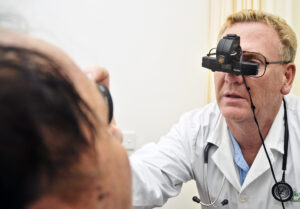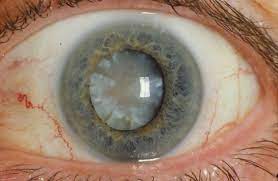Discover a natural remedy for cataracts using antioxidants found in certain plants. Learn how to incorporate these foods into your diet for better eye health. Watch
Introduction
More and more people are developing cataracts as they age, and typical treatments for cataracts often come with side effects.
So, if you’re looking for a natural alternative, this article has got you covered.
The video explains a natural remedy for cataracts using antioxidants found in certain plants, like carotenoids and anthocyanins.
By incorporating foods high in these antioxidants, such as yellow, orange, red, and purple vegetables, pasture-raised egg yolks, and berries, you can potentially decrease the risk of cataracts.
Additionally, a shake made from a blend of berries and kefir can also be beneficial.
It’s important to note that this information is for general purposes only and shouldn’t be used for self-diagnosis or as a substitute for medical advice.
With cataract surgery often leading to complications like dry eyes and droopy eyelids, natural remedies may be a better option with fewer side effects.
Blood sugar levels have a significant impact on the eyes, and high sugars can contribute to the development of cataracts.
Carotenoids and anthocyanins found in certain fruits and vegetables act as powerful antioxidants that counter oxidative stress.
Yellow, orange, red, and purple vegetables, pasture-raised egg yolks, and grass-fed meats are rich in carotenoids, while berries, including bilberries, blueberries, blackberries, and chokeberries, as well as red cabbage, are high in anthocyanins.
One of the best natural remedies suggested is a blend of berries and kefir, a fermented milk product.
It’s essential to follow a diet low in fructose, sucrose, and milk to prevent cataract development.
Cataracts: A Common Issue Among Aging Individuals
Cataracts are becoming more and more prevalent as individuals age. It is estimated that over 50% of Americans aged 80 and older have cataracts or have had cataract surgery.
Cataracts are a condition characterized by the clouding of the lens in the eye, resulting in blurry vision, sensitivity to light, and difficulty seeing at night.
While cataracts can be treated through surgery, many individuals are exploring natural alternatives due to concerns regarding the potential complications and side effects associated with surgery.
Typical Treatments for Cataracts and Their Side Effects
The most common treatment for cataracts is surgical removal of the cloudy lens and its replacement with an artificial lens.
While cataract surgery is generally safe and effective, like any surgical procedure, it is not without its risks.
Complications can include dry eyes, droopy eyelids, and floaters.
These risks may lead individuals to seek out natural remedies that have fewer potential side effects.
The Link Between High Blood Sugar Levels and Oxidative Stress in the Eyes
It is well known that high blood sugar levels can lead to oxidative stress throughout the body.
This oxidative stress can contribute to the development of cataracts.
When blood sugar is high, it creates a significant amount of oxidation or oxidative stress in the tissues, including the eyes.
The body naturally produces antioxidants to protect against oxidation and free radical damage.
However, as we age, our bodies may produce fewer antioxidants, leaving the eyes more vulnerable to oxidative stress.
The Role of Antioxidants in Countering Oxidative Stress
Antioxidants play a crucial role in neutralizing free radicals and protecting against oxidative stress.
Free radicals are unstable molecules that can cause damage to cells.
Antioxidants work by stabilizing these free radicals, preventing them from causing further damage.
In the case of cataracts, antioxidants can help counteract the oxidative stress that contributes to the clouding of the lens.

This image is property of i.ytimg.com.
Carotenoids: Potent Antioxidants in Certain Plants
Carotenoids are a group of pigments found in certain plants that possess potent antioxidant properties.
Some common carotenoids include beta-carotene, lutein, and zeaxanthin.
These carotenoids are known for their vibrant yellow, orange, red, and purple colors.
Consumption of foods high in carotenoids can help increase antioxidant levels in the body, particularly in the eyes.
Anthocyanins: Powerful Antioxidants Found in Specific Foods
Anthocyanins are another group of antioxidants found in certain fruits and vegetables.
These compounds are responsible for the vibrant red, purple, and blue colors of these foods.
Like carotenoids, anthocyanins possess potent antioxidant and anti-inflammatory properties.
Studies have suggested that anthocyanins may reduce the risk of developing cataracts as well as other age-related vision problems.
Foods Rich in Carotenoids: Promoting Eye Health
To incorporate more carotenoids into your diet, focus on consuming yellow, orange, red, and purple vegetables.
Some examples of these vegetables include carrots, sweet potatoes, bell peppers, tomatoes, and purple cabbage.
Additionally, pasture-raised egg yolks and grass-fed meats are also excellent sources of carotenoids.
Foods High in Anthocyanins: Boosting Eye Protection
To increase your intake of anthocyanins, incorporate foods such as bilberries, blueberries, blackberries, chokeberries, black currants, and red cabbage into your diet.
These fruits and vegetables not only provide essential nutrients but also offer powerful antioxidant protection for your eyes.
The Best Natural Remedy for Cataracts: A Blend of Berries and Kefir
One highly recommended natural remedy for cataracts is a simple and delicious shake made from berries and kefir.
The recipe calls for 1 cup of berries of your choice and 1 cup of unsweetened, whole milk kefir.
You can use a blender to blend the ingredients together, adding water to thin the mixture if needed.
This shake should be consumed once a day, ideally as part of a diet low in fructose, sucrose, and milk.
Dietary Considerations for Cataract Prevention
In addition to incorporating antioxidant-rich foods, it is important to be mindful of your overall diet when it comes to cataract prevention.
Avoiding foods high in fructose, sucrose, and lactose-containing milk can help reduce the risk of cataracts.
By maintaining a diet focused on whole, unprocessed foods and limiting the intake of sugars, you can support overall eye health.

Other Natural Remedies for Cataracts
Besides dietary modifications, there are a few other natural remedies that may aid in cataract prevention or treatment.
N-acetylcarnosine (NAC) eye drops can be used as an antioxidant to reduce the formation and progression of cataracts.
Additionally, consuming eggs with runny yolks can provide carotenoids and anthocyanins, further supporting eye health.
Oculotrophin PMG, a supplement from Standard Process, is commonly used for post-surgical or injury-related eye complications and may be beneficial in certain cases.
Conclusion
While cataracts are a common issue among aging individuals, there are natural remedies available that may help prevent and treat this condition.
Antioxidants, such as carotenoids and anthocyanins, found in specific foods can counteract oxidative stress in the eyes and reduce the risk of cataracts.
Incorporating a shake made from berries and kefir into your daily routine, as well as maintaining a diet low in sugar and high in whole, unprocessed foods, can contribute to better eye health.
Furthermore, considering other natural remedies, like NAC drops, egg yolks, and oculotrophin PMG, may provide additional support.
Before making any changes to your health regimen, it is important to consult with a healthcare professional.
